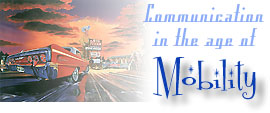
Office: HGH 210; phone: (408) 924-5378
Email: wooda@email.sjsu.edu
Web: http://www.sjsu.edu/faculty/wooda
 |
Dr. Andrew Wood Office: HGH 210; phone: (408) 924-5378 Email: wooda@email.sjsu.edu Web: http://www.sjsu.edu/faculty/wooda |
Introduction
: Course Calendar : Policies
: Readings
Assignments : Check Your Grades : Return
to Frontpage
Study guide: Focus on (1) U.S. prototype for interstate highway system, (2) founders' fears of federal highway system, (3) name of the road that frequently parallels an interstate highway, (4) ideal distance of motel from major metropolitan area, (5) typical plants at interstate highway offramp convenience stores.
The reading (pp. 88-101 and 157-168) introduces the notion that highways and their resting-places represent practical responses to the problems of contemporary life that significantly limit the experiences of its travelers. Initially, Stilgoe discusses the multiple meanings of "limited access." What are the implications of a nation-girdling road system that privileges some forms of transportation while making others virtually impossible? Answering this query, Stilgoe outlines the military history of the interstate system, describing the Pennsylvania Turnpike as an experiment in rapid transportation designed to facilitate the rapid movement of tanks and troops from border to border in wartime. As such, the interstate begins to represent more than a simple means of transit.
To the explorer stopped atop a bridge arching over the twin ribbons of asphalt or concrete, the interstate highway becomes many things, an engineering marvel, almost an art form disappearing into the distance, perhaps a corridor of the imagination, always an expression of the power of the national government. (p. 89)
Intriguingly, the federal government could not actually build an interstate highway to follow up on the experimentation of the Turnpike and the German autobahn because, it was feared, such a system would help centralize a tyrannical government. Thus, the interstate was funded as a national security measure in case of nuclear conflict in 1950s or 60s. Along the way, the network of highways played a distressing role in the destruction of ethnic neighborhoods and, according to some critics, diminished the cohesion of voting blocks who could challenge white dominated governments. Among the unintended consequences of the interstate highway system, Stilgoe notes its impact on small towns who frequently lost their viability after their prewar highway arteries were severed.

In chapter eight, Stilgoe explores cloverleaf motels as sites of social interaction and describes off-ramp businesses as manicured pit-stops devoid of meaning. In this chapter, Stilgoe concentrates on postwar motels rather than the smaller mom and pop tourist courts that predate the interstate era. Intriguingly, these full service motels like Holiday Inn replaced more traditional sites of public life, their pools offering the promise of easy sociability.
Like the fireplace of ancient inns, the pool gathers in strangers, and strangers begin to talk. Water loosens the spirit, relaxes, somehow looses the mangle of reserve with which traveling Americans now clothe themselves, and provides a smidgen of the Bahamas, Grenada, Aruba next to asphalt. (p. 162)
Stilgoe concludes with a discussion of the ephemeral nature of cloverleaf architecture, obsessed with cleanliness and renewal. He notes that stops along the interstate highway offer opportunities for consumption, only: a night's stop in a room, a quick hamburger, a few more gallons of gas. In fact, an industry of trinket sales has grown in the attempt to transform these sites into places worthy of memory. Stilgoe asks:
What exactly makes interstates so peculiarly forgettable, so exquisitely unseeable? The explorer who stops early at a motel and spends an hour or so walking around not only stretches muscles but stretches concepts of place. An interchange is not a village, not a station, not something with its own zip code. It is a place to park, to get out and walk and look, to see a piece of landscape wrenched from tradition and somehow insinuating that well-kept places are the easiest to forget. (p. 168)
Activity
Think back to Stilgoe's description of the backside of a highway green sign that is covered with graffiti, unseen by the passing motorist (p. 98). What other kind of hidden narratives or "unauthorized" spaces can you find along the interstate? Visit a space near or under highway 101 or a similar road where motorists are unlikely to travel. For your Show and Tell activity, describe this scene in detail. What uses for this space exist beyond its apparent role as a conveyance for motorists? Remember: safety is your first concern. Park your car legally and well away from traffic. Be aware of your surroundings and proximity to moving traffic and other people.